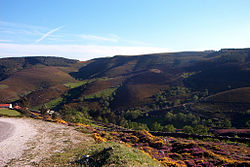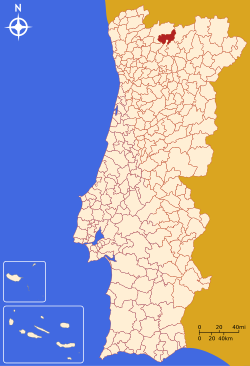Boticas Municipality
| Boticas | |||
|---|---|---|---|
| Municipality | |||

The Serra da Barroso, between Salto and Boticas
|
|||
|
|||
 |
|||
| Coordinates: 41°41′14″N 7°40′4″W / 41.68722°N 7.66778°WCoordinates: 41°41′14″N 7°40′4″W / 41.68722°N 7.66778°W | |||
| Country |
|
||
| Region | Norte | ||
| Subregion | Alto Trás-os-Montes | ||
| Intermunic. comm. | Alto Tâmega | ||
| District | Vila Real | ||
| Parishes | 10 | ||
| Government | |||
| • President | Fernando Pereira Campos | ||
| Area | |||
| • Total | 321.96 km2 (124.31 sq mi) | ||
| Elevation | 883 m (2,897 ft) | ||
| Population (2011) | |||
| • Total | 5,750 | ||
| • Density | 18/km2 (46/sq mi) | ||
| Time zone | WET/WEST (UTC+0/+1) | ||
| Postal code | 5460 | ||
| Area code | 276 | ||
| Patron | Nossa Senhora da Livração | ||
| Website | http://www.cm-boticas.pt | ||
Boticas (Portuguese pronunciation: [buˈtikɐʃ]) is a municipality in northern Portugal. The population in 2011 was 5,750, in an area of 321.96 km².
One of the symbols of Boticas is the Galaico Warrior, an anthropomorphic carved monolith (found in the 17th century) in the castro of Lesenho, at an altitude of 1075 metres, under fields of the parish of São Salvador de Viveiro and municipality of Boticas, considered the most important Gallaecian castro in Portugal. The Galaico (or "Castrejo") Warrior is an important example of Portuguese archaeology and represents, according several experts, the image of a deity and warrior of "castreja" civilisation that lived in this area of Portugal.
There were several castros (27) dating back to this early civilization, in addition to various Roman monuments. Boticas has its origins in the Roman civitas Batocas, that was centre of mining, and its Termas de Carvalhelhos, thermal springs with (supposedly) rejuvenating miracle waters. Coins from the period of Byzantine Emperor Constantine X Doukas were also found in Covas de Barroso in 1880, in addition to vestiges in Poços das Freitas or the mines of Carvalhelhos, where Romans were known to have mined gold and silver.
No later then 314, Boticas (or Betecas) also became a diocese, as the episcopal term of its only recorded bishop, Sabino (death unknown), starts then. It was presumably suppressed around 400, without direct successor see.
Waves of barbarian tribes and Moorish invaders crossed the lands of Boticas during the Middle Ages (many of the local toponomic names reflect this period, such as Côto dos Mouros, Penedo dos Mouros, Estrada dos Mouros, Cova da Moura, Moura Encantada and Mouril).
The Barroso surname, which figures prominently in the history of the region, has its origin in the Terras de Barroso, in the Trás-os-Montes. Its first use, came from lineage of the Guedeões (taken from a tower in the locality of Sipiões), whose progeny would adopt and permeate the lands of Botica. King Afonso II tried to unite the lands of the Barrosos in 1273, but was unable.
...
Wikipedia


